How to Fix Photoshop Scratch Disk Full Errors
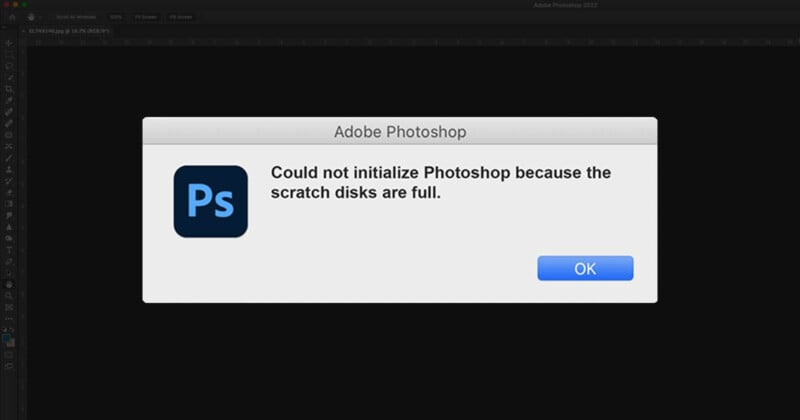
One of the most common errors when using Adobe Photoshop has to do with Photoshop not being able to start or complete a command because “the scratch disks are full.”
Fortunately, there are many simple solutions to this problem and steps you can take to help prevent it from happening again. This guide will help you understand what to do when Photoshop is having scratch disk issues.
What Is a Scratch Disk, and Why Is It Full?
It’s important to understand what “disk” is referring to in the first place. In a computer, hard disk drive, hard disk, hard drive, and fixed disk all refer to the physical data storage device that stores your computer’s operating system, apps, and other files. Luckily, issues with your scratch disk have nothing to do with anything being physically scratched!
A scratch disk is essentially a temporary storage space for data. Photoshop is a complex program that works with large files, so it designates a hard disk as a scratch disk to hold the data that it works with. The hard disk that it uses is usually your computer’s built-in disk, but it’s possible (and fairly common) to connect an external hard drive to your computer and designate it as Photoshop’s scratch disk location.
If you’re getting “scratch disk full” errors, your hard disk (which is likely your computer’s built-in storage space) is just running out of available space. Photoshop doesn’t have enough space to store its temporary files, and it cannot operate normally.
How To Fix Photoshop Scratch Disk Errors
Here are steps you can try to get rid of the scratch disk error message and get Photoshop working correctly again.
Free Up Storage Space on Your Computer’s Hard Drive (Most Important)
First, you probably want to check how much storage space you have left. On Mac, open System Settings, go to General, and click Storage. This will tell you how much storage space is remaining on your hard drive. On Windows, click the Start button, open Settings, go to System, and click Storage. Both storage menus will allow you to see what is taking up space on your hard drive.
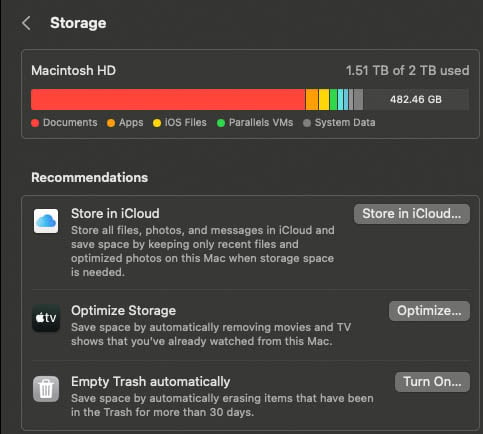
How much free space do you really need? It depends, but according to Adobe’s website, “If you make small changes only, you need a minimum of 10 GB scratch disk space for Photoshop (with default preferences, brushes, patterns, etc). It is recommended to have a minimum of 20 GB of free space on your OS hard drive while working with Photoshop.” It varies, depending on your file size, but the more free space, the better and safer in the long run.
Once you’ve figured out how much space is remaining, you should free up space by deleting files that you no longer need. If your computer moves files into Trash (Mac) or Recycle Bin (Windows), make sure to empty those folders after deleting the files. You could also perform this step before deleting anything because these folders take up space on your hard drive (even though you’ve already deleted the files in these folders). Remove apps that you no longer use, unnecessary photos, videos, documents, and even messages if you use your computer for iMessage (Mac).
If you don’t want to delete items, consider moving them to a separate hard drive. These are available for purchase in many different sizes. External drives are good for storing photos, videos, documents, and similar items.
Tip: If you frequently import photos into Adobe Lightroom without using an external hard drive, the photos will be stored in folders created by Lightroom. It’s easy to forget that these exist, and they often take up a lot of storage space on your hard drive. Especially if you work with RAW files, it is useful to find out where Lightroom is storing files. If you need more storage space, move these files to a separate hard drive or delete them if you’re sure you no longer need them.
Clear Photoshop’s Cache
If you are able to open Photoshop, try clearing Photoshop’s cache. Be aware that this will likely remove any opportunities to “undo” changes to an image because it will clear the edit history. To do this, go to Edit, click on Purge, and select All. This is especially useful when working with large files because lots of small changes on a large file will amount to a large amount of scratch disk space reserved for saving the edit history.
Check Your Cropping and Resizing Units
In the Crop, Image Size, and Canvas Size dialogues, you may have accidentally selected the wrong units. For example, if you chose to work in inches when you actually wanted to work in pixels, this might have accidentally created a large file that filled up the scratch disk. If you were using the Crop tool and got an error, try pressing the “Clear” button near the top of the screen.
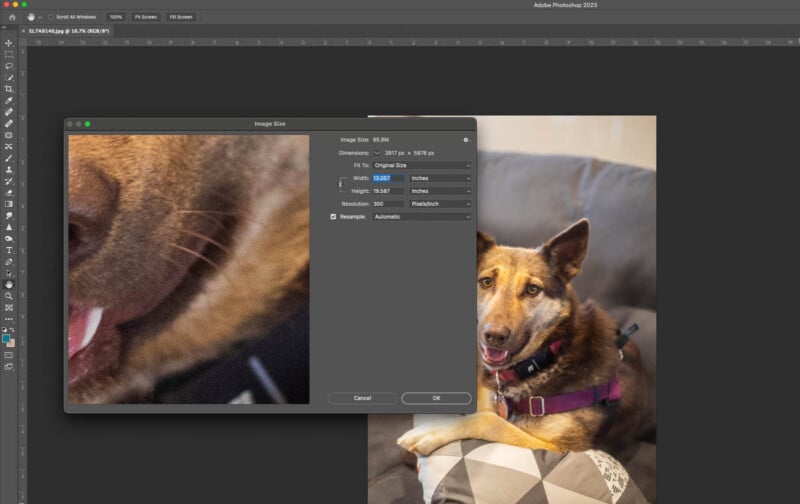
Reset Photoshop’s Preferences
According to Adobe, “when Photoshop or the system crashes, Photoshop’s preference file can get corrupted and this can affect Photoshop’s handling of scratch disks.” To reset preferences, open Photoshop Settings and go to General. Click “Reset Preferences on Quit.” When you quit and relaunch Photoshop, new preference files will be created and the old ones will be deleted.
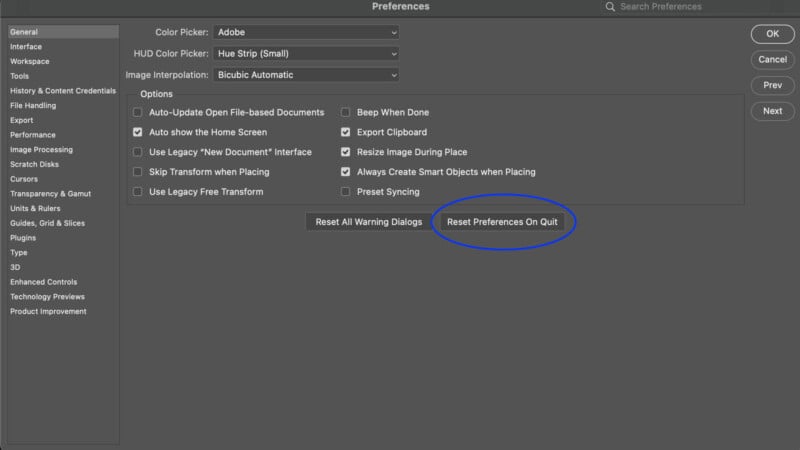
How To Help Prevent Photoshop Scratch Disk Errors
There are also some things you can do to reduce the chances you’ll run into Photoshop’s annoying scratch disk errors in the future.
Change the Scratch Disks or Assign Multiple
Similar to freeing up storage space on your existing hard drive, you can point Photoshop to a different hard drive that has free space for Photoshop’s scratch disk. To open Scratch Disk Preferences, go to Settings and click on Scratch Disks. You can also change scratch disks by holding Command+Option (Mac) or Control+Alt (PC) while you launch Photoshop (this is especially useful if you’re having a hard time getting Photoshop open in the first place).
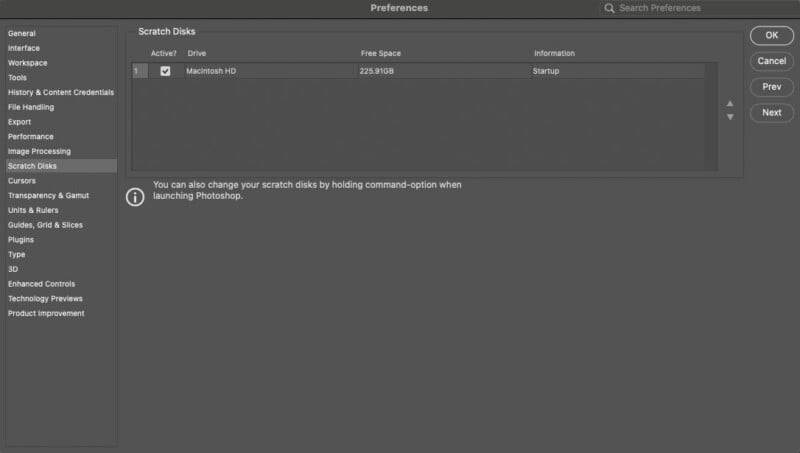
From here, you can select a different scratch disk if there’s one available, such as an external hard drive that has free space. You can allocate multiple scratch disk locations as well, in case one fills up and there is free space on another.
Many people use an external hard drive with free space every time they use Photoshop so that there’s plenty of space for Photoshop’s scratch disks. Many different formats of external hard drives are available online or at electronics stores for fairly reasonable prices, depending on size and quality. In general, it’s a good idea to make sure you have plenty of free storage space on your computer’s built-in hard drive. This will help everything run more smoothly, not just Photoshop.
Adjust Performance Settings
From Settings, click on Performance. You can adjust how much memory Photoshop is able to use related to your available memory (also called random-access memory, or RAM). Newer versions of Photoshop will give an ideal range for Photoshop operation. The default is 70% of available memory, and Adobe recommends keeping the value to less than 85% of your available memory so that there’s enough for the rest of your system to operate.
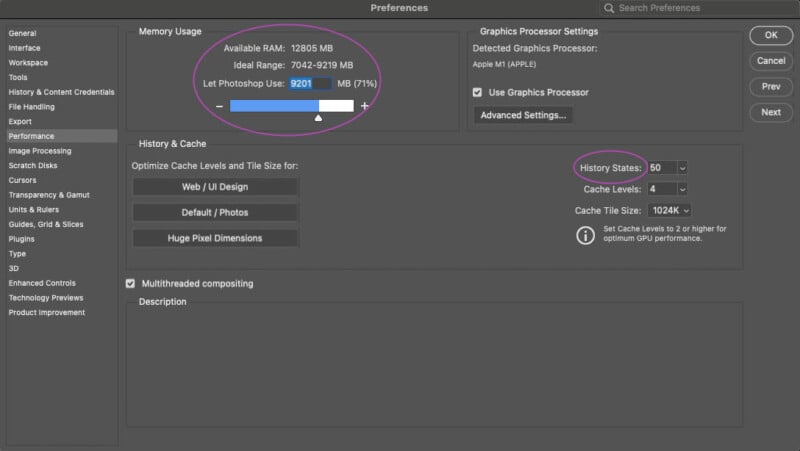
You can also change the number of history states that Photoshop saves, which is defaulted to be 50. If you’d like to save space, lower this number so that Photoshop will use less space by saving fewer history states. Of course, there are drawbacks to having too few history states, especially if you are making small changes to a file.
Disable or Edit the Auto Recovery Feature
In case Photoshop crashes, there is an auto-recovery save feature that saves recovery information periodically. This takes up space, and it can be adjusted. From Settings, click on File Handling, find the setting that says “Automatically Save Recovery Information Every,” and see whether it’s checked or not.
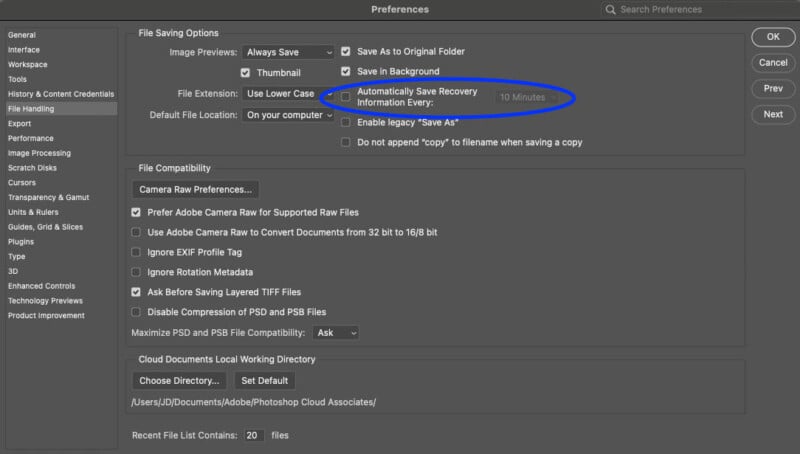
If it’s unchecked, there is no automatic recovery saving enabled. If it is checked, you can change the time between saves.
Disabling the feature entirely will help prevent scratch disk issues most effectively, but if Photoshop crashes, there will be no recovery information saved. Simply changing the saving interval would make less of an impact, but it would help the scratch disk fill up at a slower rate if you increase the time between saves.
Conclusion
Overall, issues with the scratch disk are common among Photoshop users.
Photographers tend to work with a lot of files that take up a lot of disk space, so it’s easy to lose track of how much free space is available. Keeping enough free disk space will not only help prevent scratch disk errors, but it will help your computer run more smoothly as well.
If you’re getting serious about photography or if you take lots of photographs, it’s a good idea to invest in an external hard drive or two so that your images don’t take up all of the built-in hard drive space on your computer.
Photoshop is a complex program with many features that require scratch disk space. You can prevent scratch disk errors by adjusting these features and making it so that Photoshop requires less space to run.